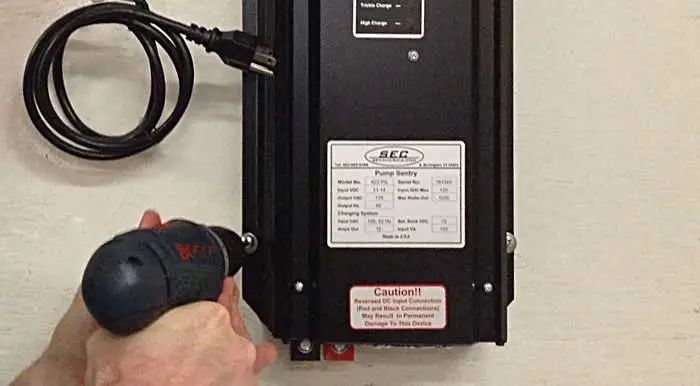Adding a battery backup to an existing sump pump is definitely possible for most homeowners. With the right parts and some basic electrical and plumbing skills, a battery backup can provide peace of mind by ensuring your sump pump keeps working during a power outage.
Page Contents
Why Add a Battery Backup?
A sump pump is an essential appliance for many homeowners with basements or crawlspaces. It removes water that collects in the sump basin and pumps it away from the house. But when the power goes out, a regular AC-powered sump pump will stop working. That’s where a battery backup comes in – it allows the sump pump to keep operating for hours or even days until utility power is restored.
Without a backup system, a loss of power combined with heavy rain or melting snow can quickly lead to flooding in the basement. Water damage from even a few inches of water can cost thousands in repairs. A good battery backup is inexpensive insurance against expensive flooding.
Choosing a Battery Backup System
The most popular type of battery backup system for sump pumps is a standalone DC (direct current) battery unit that attaches externally to the pump. This type of backup fits with most sump pump models and is a relatively easy DIY installation. DC battery backups provide power for 8-72 hours depending on the battery capacity.
Some key features to look for in a battery backup include:
- Enough power output for your pump size – match the amp hour rating
- Long runtime – 24hr+ is recommended
- Battery/charge monitoring
- Auto-switching to battery in outage
- Alarm or indicator when running on battery
When comparing backups, larger capacity batteries come at a higher cost but provide longer protection. Batteries rated for at least 24 hours of runtime are ideal for surviving most power outages. Some systems use multiple battery packs for 48 hours or more of operation.
Installation Guide
Installing a battery backup involves both electrical work for wiring and some plumbing changes. Make sure to follow all safety precautions when dealing with electricity and water.
Typical installation steps include:
- Shut off power to the pump circuit at the circuit breaker.
- Disconnect the pump from the AC power source.
- Mount the backup unit on the wall near the sump pit.
- Connect the backup power cables to the pump per the manufacturer directions.
- Attach the pump discharge pipe to the backup unit if needed.
- Install the included power cable and float/sensor switch in the sump pit.
- Wire the backup power supply to the electrical panel.
- Reconnect AC power to the panel circuit for the pump.
- Test that the system switches to battery power when unplugging the pump.
Following the detailed installation instructions provided with your backup battery is key. Some systems require an additional control module or panel upgrades to integrate properly. Take your time and do not skip steps when installing the backup system.
Maintenance Tips
Like any system, some periodic maintenance is required to keep a battery backup for your sump pump in good working order:
- Check the battery charge monthly and after any extended outages.
- Clean and inspect the sump pit for debris annually.
- Test the backup system under load once per year.
- Replace the battery every 2-3 years or per manufacturer specifications.
Proactively replacing the battery before its end of life is crucial to avoiding pump failures during an outage. Mark your calendar to swap out the battery a few years after installation.
Some backup units also allow you to supplement the integrated battery with an external car or marine battery for extended runtimes. Just make sure to use a compatible deep cycle battery.
Professional Installation
If tackling the electrical and plumbing work involved seems complex, consider hiring a professional for installation. A qualified handyman, plumber, or electrician can correctly size, install, and integrate the backup system with your existing pump.
Hiring a pro takes all the hassle out of the project and provides peace of mind that it was done right. Expect to pay $200-$500 or more for installation services, depending on system complexity and local rates.
Costs
A standalone battery backup system for your sump pump will cost anywhere from $150 up to $1,000 or more, depending on the capacity, features, and runtime. Higher capacity batteries with longer runtimes come at a higher price. However, the cost is very reasonable compared to the damage even minor flooding can cause.
Installation costs can add $200-$500 or more if you have the work professionally completed. In total, most homeowners spend $400-$800 to add a quality battery backup system to an existing AC sump pump.
Key Takeaways
- Adding a battery backup provides protection against basement flooding during outages.
- Choose a DC backup with enough power for your pump and long runtime.
- Installation takes some electrical and plumbing modifications.
- Maintenance involves occasional testing and battery replacement.
- Total costs range from $400-$800, with higher capacity units costing more.
Conclusion
Upgrading an existing sump pump with a battery backup system is an excellent way to provide protection during power outages. A quality DC battery unit running your pump for 24 hours or more is ideal. Units are available at reasonable costs for most homeowners. With proper installation and periodic maintenance, a battery backup can provide years of reliable protection from basement flooding due to loss of power.

